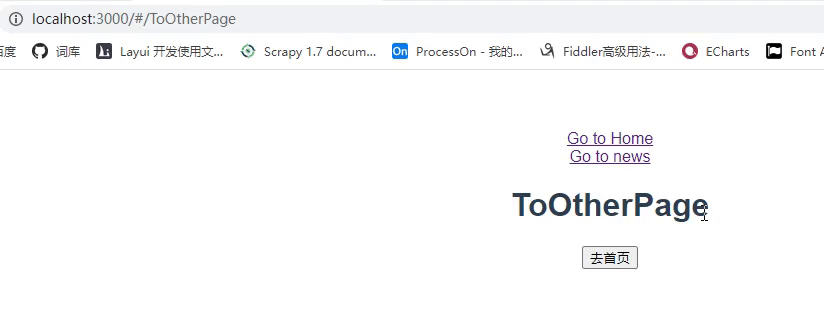
Vue 点击按钮跳转其他链接
需要实现效果如下:流程:1.在(Vue3 Router(路由)的基本使用_Zhichao_97的博客-CSDN博客)基础上,在vue3Router01>src>compontents新建组件ToOtherPage.vue,如下图:ToOtherPage.vue:<template><div><h1>ToOtherPage</h1><
·
需要实现效果如下:

流程:
1.在(Vue3 Router(路由)的基本使用_Zhichao_97的博客-CSDN博客)基础上,在vue3Router01>src>compontents新建组件ToOtherPage.vue,如下图:

ToOtherPage.vue:
<template>
<div>
<h1>ToOtherPage</h1>
<button @click="ToOtherPage">去首页</button>
</div>
</template>
<script>
export default {
name: "ToOtherPage",
methods:{
ToOtherPage(){
this.$router.push("/")
// this.$router.push({path:'/'})
// 袖带参数跳转
// this.$router.push({path:"/xxx/123456"})
// this.$router.push({name:"xxx",params:{id:12345}})
// this.$router.push({path:"/",query:{keyword:'cc'}})
}
}
}
</script>
<style scoped>
</style>2.在vue3Router01>src>router>index.js中修改代码如下:
import {createRouter,createWebHashHistory} from 'vue-router'
import Home from "../components/Home.vue"
import ToOtherPage from "../components/ToOtherPage.vue";
// 1. Define route components.
// These can be imported from other files
// 2. Define some routes
// Each route should map to a component.
// We'll talk about nested routes later.
const routes = [
{
// name:"xxx",
path: '/',
component: Home
},
{
path:'/ToOtherPage',
component:ToOtherPage
},
]
// 3. Create the router instance and pass the `routes` option
// You can pass in additional options here, but let's
// keep it simple for now.
const router = createRouter({
// 4. Provide the history implementation to use. We are using the hash history for simplicity here.
history: createWebHashHistory(),
routes, // short for `routes: routes`
})
export default router如果要实现带这种形式的参数:
![]()
在ToOtherPage.vue中,使用此方式实现:

更多推荐
 已为社区贡献4条内容
已为社区贡献4条内容







所有评论(0)